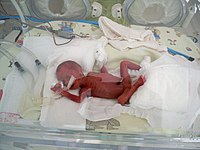
Photo from wikipedia
ABSTRACT Background: The global burden of stillbirth and neonatal deaths remains a challenge in low-income countries. Training in neonatal resuscitation can reduce intrapartum stillbirth and early neonatal mortality. Previous results… Click to show full abstract
ABSTRACT Background: The global burden of stillbirth and neonatal deaths remains a challenge in low-income countries. Training in neonatal resuscitation can reduce intrapartum stillbirth and early neonatal mortality. Previous results demonstrate that infants who previously would have been registered as stillbirths are successfully resuscitated after such training, suggesting that there is a process of selection for resuscitation that needs to be explored. Objective: To compare neonatal resuscitation of low birth weight and normal birth weight infants born at a facility in a low-income setting. Methods: Motion-triggered video cameras were installed above the resuscitation tables at a maternity health facility during an intervention study (ISRCTN97846009) employing the Helping Babies Breathe resuscitation protocol in Kathmandu, Nepal. Recordings were analysed, noting crying, stimulation, ventilation, suctioning and oxygen administration during resuscitation. Birth weight, Apgar scores and sex of the infant were retrieved from matched hospital registers. The results were analysed by chi-square and logistic regression. Results: A total of 2253 resuscitation cases were recorded. Low birth weight infants in need of resuscitation had higher odds of receiving ventilation (aOR 1.73, 95% CI 1.24–2.42) and lower odds of receiving suctioning (aOR 0.53, 95% CI 0.34–0.82) after adjustment for the Helping Babies Breathe intervention, sex of the infant and place of resuscitation within the facility. The rates of stimulation and administration of oxygen were the same in both groups. Conclusions: Low birth weight was associated with more ventilation and less suctioning during neonatal resuscitation in a low-income setting. As ventilation is the most important intervention when the infant does not initiate breathing after birth, low birth weight was not a predictor for the decision to withhold resuscitation. Frequent routine use of suctioning of the lower airways continues to be a problem in the studied context, even after the introduction of the Helping Babies Breathe protocol.
Journal Title: Global Health Action
Year Published: 2017
Link to full text (if available)
Share on Social Media: Sign Up to like & get
recommendations!